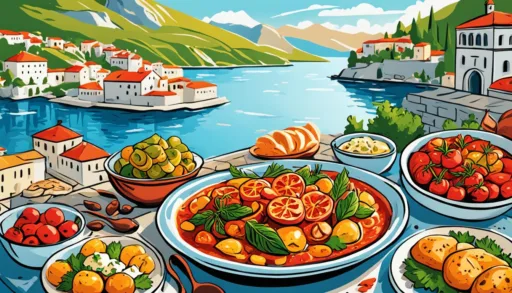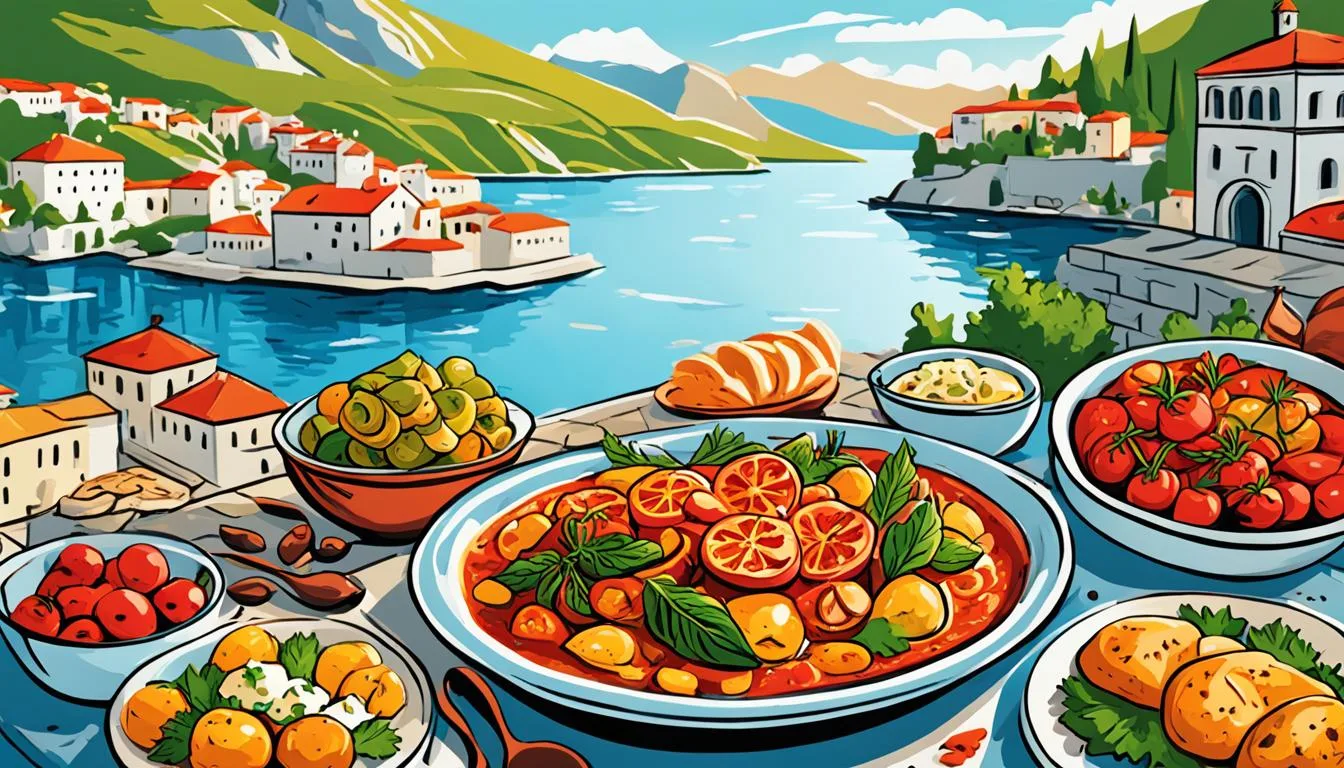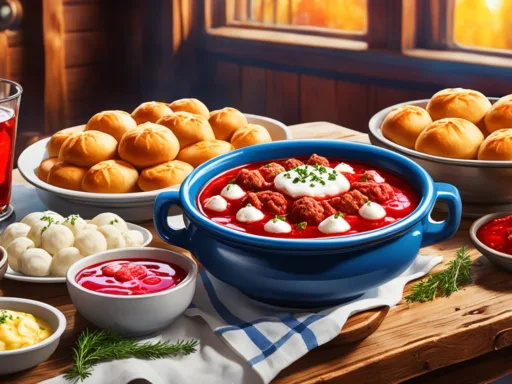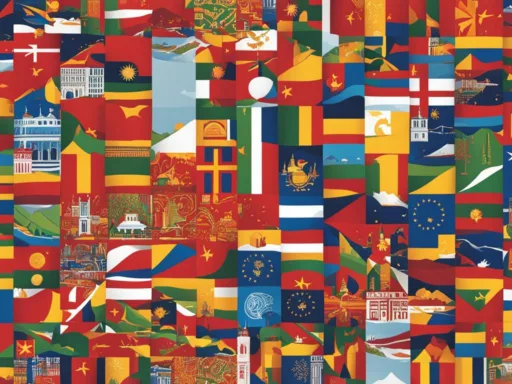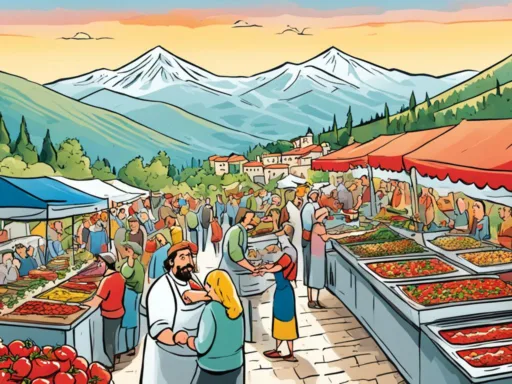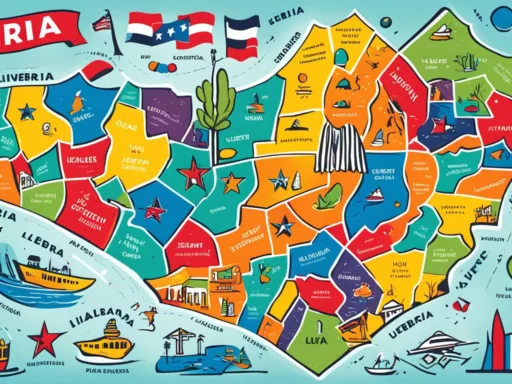Imagine embarking on a culinary journey so diverse and rich, it tantalizes your taste buds with a symphony of flavors formed at the crossroads of empires and ages. Welcome to the delectable world of Montenegro, a hidden European gem where every dish tells a story. With a Montenegrin Food Guide in hand, prepare to dive into an epicurean experience where Montenegrin cuisine takes center stage, offering a treasure trove of traditional Montenegrin dishes fashioned by the whispers of history and the proud roots of its people. This is more than just food; it’s a Montenegro culinary experience that promises to transform the way you perceive and enjoy the art of eating.
From the mountain-rimmed landscapes to the sun-kissed coast of the Adriatic, Montenegro’s food scene is a captivating blend of Mediterranean elegance and Balkan heartiness. Whether a seasoned traveler or a curious foodie, prepare for an unforgettable journey through a nation’s culinary soul.
Key Takeaways
- Montenegro’s diverse cuisine offers a unique blend of Mediterranean and Balkan flavors.
- Traditional Montenegrin dishes provide a rich narrative of the country’s cultural heritage.
- A Montenegrin Food Guide is crucial for exploring the country’s regional culinary specialties.
- Experiencing a Montenegro culinary journey can challenge and expand your palate’s horizons.
- The complexity and richness of Montenegrin cuisine reflect its historical influences and geographical diversity.
- Montenegro presents a vibrant food scene that caters to carnivores and vegetarians alike.
The Historical Palette of Montenegrin Cuisine
Montenegrin food culture is a vibrant tapestry that reflects the rich threads of its Mediterranean heritage and Balkan gastronomy. An exploration into Montenegrin food history reveals a cuisine shaped by the hands of time and nature, an enduring legacy of flavors and techniques passed through generations.
Roots in Mediterranean and Balkan Traditions
The shores of the Mediterranean and the rugged terrain of the Balkans have both carved a deep influence on the way Montenegro eats and celebrates food. Olive oil, fresh seafood, sun-ripened vegetables, and herbs are staples that bespeak the region’s Mediterranean ties, whereas heartier dishes of meat and dairy are reminiscent of the Balkan’s pastoral leanings.
The Influence of History on Modern Montenegrin Dishes
Throughout centuries, Montenegro’s culinary canvas has been colored by various empires and civilizations, each leaving a unique brushstroke on the present-day Montenegrin plate. Even now, one can taste the simplicity of agrarian life melding with the sophisticated flavors from historical conquests, embodying a modern-day feast that honors its storied past.
| Historical Influence | Montenegrin Dish | Signature Ingredients |
|---|---|---|
| Mediterranean | Seafood Buzara | Shrimps, Mussels, White Wine, Garlic, Parsley |
| Ottoman | Burek | Filo Pastry, Minced Meat, Cheese, Spinach |
| Central European | Kajmak | Cream, Salt |
| Balkan | Cevapi | Grilled Minced Meat, Onions, Flatbread |
Montenegrin Food Guide: A Tapestry of Flavors
Embark on a culinary odyssey through Montenegro and revel in the rich tapestry of flavors that define its traditional cuisine. From hearty meat specialties to refreshing salads and delectable desserts, explore a menu that speaks of Montenegro’s complex history and diverse geographical influences.
Iconic Meat Dishes: Burek to Njeguski Steak
The heart of Montenegrin food lies in its meat dishes, beloved across the country. Burek, though not native to Montenegro, has become a beloved staple, with its flaky pastry layers encasing succulent fillings of meat, cheese, or spinach. An absolute must-try is the Njeguski Steak, a savory celebration of Montenegrin cuisine, crafted with prosciutto and cheese enveloped in tenderized beef, embodying the essence of local tradition and flavor.
Sopska and Shopska Salads: A Vegetarian’s Delight
Montenegrin food specialties also cater lovingly to the vegetarian palate. Both Sopska and Shopska Salads burst with the freshness of tomatoes, cucumbers, and onions, crowned with a generous topping of feta cheese. These salads are not just sides but a staple in the Montenegrin culinary scene, offering a refreshing and healthy option that’s as filling as it is delicious.
Montenegrin Sweet Treats: From Krostule to Pita od Dunja
For those with a sweet tooth, Montenegrin desserts offer a delightful end to any meal. Krostule are delightful fried pastry ribbons dusted with powdered sugar, perfect with coffee or as a standalone treat. The fruit-filled, syrupy Pita od Dunja exemplifies the fusion of Mediterranean flavors and Ottoman influences that have shaped the country’s dessert offerings.
| Montenegrin Dish | Type | Key Ingredients | Origin |
|---|---|---|---|
| Burek | Savory Pastry | Meat, Cheese, Spinach | Ottoman Influence |
| Njeguski Steak | Meat Entree | Beef, Prosciutto, Cheese | Montenegro |
| Sopska Salad | Salad | Tomato, Cucumber, Feta Cheese | Balkan |
| Shopska Salad | Salad | Tomato, Cucumber, Onion, Feta Cheese | Balkan |
| Krostule | Dessert | Flour, Eggs, Sugar | Mediterranean |
| Pita od Dunja | Dessert | Quince, Dough, Syrup | Mediterranean & Ottoman |
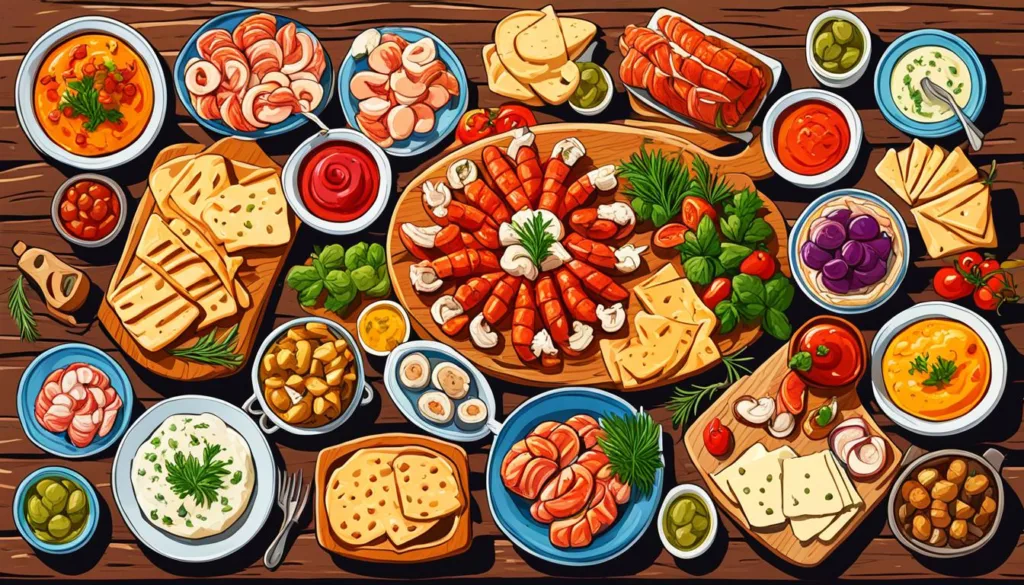
Montenegro’s Meat Mastery: A Carnivore’s Haven
As a country with a rich history of gastronomy, Montenegro offers a feast for the carnivore in traditional offerings. The spirit of Montenegrin meat dishes is captured through time-honored cooking techniques and a devotion to flavor. While trekking through the mountainous regions or strolling along the crystal-clear Adriatic coastline, one encounters authentic Montenegrin recipes that marry the rustic charm of the Balkans with the refined tastes of Mediterranean cuisine.
Exploring Traditional Meat Dishes
Montenegro’s love affair with meat can be tasted in every bite of their time-honored dishes. To understand the soul of Montenegrin cuisine, one must delve into the beloved recipes that have been passed down through generations. This culinary journey reveals the heartiness of local flavors and the skilled craft of Montenegrin cooks.
- Cevapi: Small grilled meat sausages made of lamb and beef mix, these bite-sized delights are often served with flatbread and a savory onion sauce.
- Pljeskavica: A Balkan staple, this spiced meat patty is a festival of flavors, usually served within local bread, with toppings like ajvar, a red pepper-based condiment.
- Kuvani Brav: This slow-cooked lamb dish, simmering in its juices alongside a selection of vegetables and herbs, epitomizes the Montenegrin love for hearty meals.
Seafood Offerings Along the Adriatic Coast
Montenegro’s Adriatic seafood is a testament to its geographic gift, where the bountiful sea offers up treasures that are as fresh as they are delectable. Here, the savory essence of the sea is celebrated in every dish, presenting diners with a chorus of oceanic flavors.
| Seafood Dish | Description | Origin |
|---|---|---|
| Riblja Čorba | Hearty fish stew made with a tomato base, often infused with local herbs and a variety of Adriatic fish. | Coastal regions |
| Pastrmka na žaru | Grilled trout seasoned with Mediterranean spices, showcasing the simplicity of coastal cooking. | Lake Skadar area |
| Skadar Lake carp | Famous for its delicate texture, this carp is typically grilled and served alongside fresh greens. | Lake Skadar’s vicinity |
The intersection of land and sea within Montenegrin cuisine presents an array of top Montenegrin dishes that rival those of any global culinary powerhouse. From succulent meat seasoned to perfection to the freshest of Adriatic catch, Montenegro’s culinary canvas offers a picturesque array of flavors waiting to be discovered.
The Vegetarian Side of Montenegrin Cuisine
Exploring the vegetarian Montenegrin cuisine uncovers a fresh perspective on the rich tapestry of flavors that this Balkan nation offers. Away from its famed meats and seafood, the Montenegrin kitchen presents a hearty selection of authentic Montenegrin recipes that celebrate the quality of local produce and the traditional methods of preparation.
One standout dish that exemplifies vegetarian simplicity and comfort is Kačamak, a creamy polenta-like cornmeal concoction that is often enriched with kajmak (a creamy dairy delicacy) or cheese. Its origins stem from the rugged mountain regions, where hearty meals like this provided sustenance for the farmers and shepherds.
Beyond Kačamak, the vegetarian scene is dotted with Balkan vegetarian delicacies that are both light and nourishing. Listed below are some must-try vegetarian dishes that boast the flavors of Montenegro without the meat:
- Japraci without meat: Grape leaves stuffed with a mix of rice and vegetables, offering a burst of Mediterranean aromas.
- Fluffy Pogaca: A traditional bread that pairs well with a spread of olive oil and herbs.
- Zucchini Bujara: Zucchini simmered in a rich, savory sauce of tomatoes and garlic, reflecting the essence of summer gardens.
For those who delight in exploring through taste, the following table presents a comparative look at some of Montenegrin’s popular vegetarian dishes:
| Dish | Main Ingredients | Flavor Profile | Origin |
|---|---|---|---|
| Kačamak | Cornmeal, kajmak or cheese, and sometimes potatoes | Creamy, rich, and comforting | Mountain regions |
| Montenegrin Salad | Fresh tomatoes, cucumbers, onions, and olives topped with cheese | Fresh, crisp, and tangy | Coastal areas |
| Blitva | Swiss chard, potatoes, olive oil, and garlic | Earthy with a slight bitterness, balanced with richness from the olive oil | Widespread |
These vegetarian Montenegrin cuisine offerings are not only mouth-watering but also seamlessly integrate into the wide array of Balkan vegetarian delicacies, proving that the Montenegrin culinary experience can cater to all palates with equal gusto.
A Deep Dive into Montenegrin Sea and Orchard Delights
The shores and orchards of Montenegro offer a treasure trove of flavors that beckon food enthusiasts to delve into the country’s aquatic and agricultural richness. Savor the sea’s bounty, epitomized by the renowned Kotor Bay oysters, a highlight of Montenegrin seafood. Venture inland, and you’ll be greeted by orchards abundant with Montenegrin fruits—an array of blueberries, grapes, and peaches that are as delightful to the eye as they are to the palate.
Fresh Seafood and the Fame of Kotor Bay Oysters
Montenegro’s coastal waters yield an exquisite variety of fish and shellfish, with the Kotor Bay oysters holding a place of honor. These oysters are not merely food items; they are part of Montenegro’s cultural heritage, making them a must-try for any visitor. Their rich, briny flavor captures the essence of the Adriatic and leaves a lasting impression of Montenegro’s deep connection to the sea.
The Luscious Fruits of Montenegrin Orchards
Amble through the tranquil orchards of the Montenegrin countryside, where traditional farming methods allow for fruits to ripen naturally. The result is a burst of vibrant colors and flavors, from the deep blues of blueberries to the radiant hues of peaches and grapes, each fruit telling its own unique story of the region’s fertile lands.
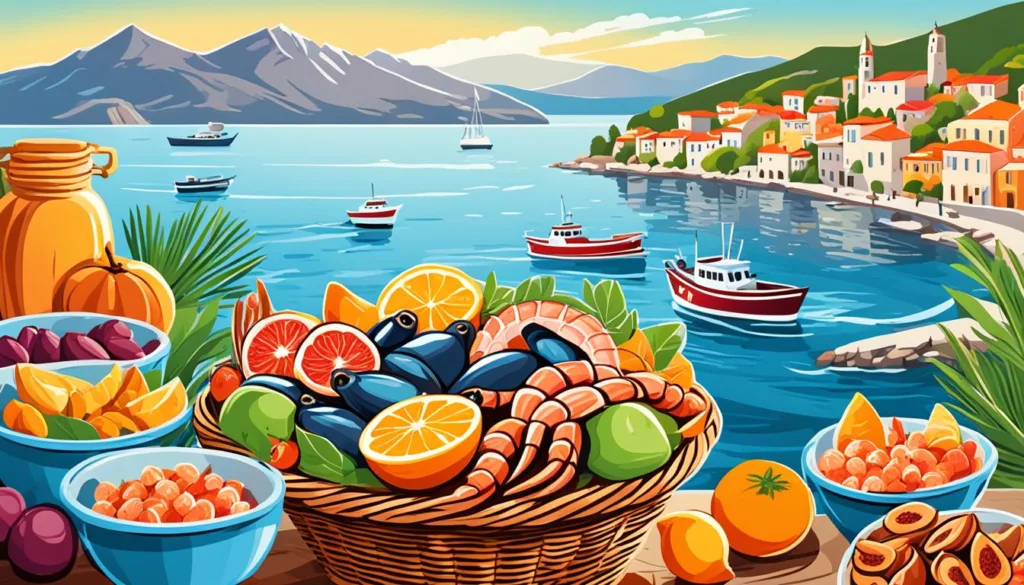
For those who desire to understand the breadth of Montenegrin produce, consider the following table that juxtaposes the coastal offerings with the inland orchard bounty:
| Seafood Delicacy | Season | Orchard Fruit | Harvest Time |
|---|---|---|---|
| Kotor Bay Oysters | Year-round, peak in spring | Montenegrin Blueberries | June to August |
| Adriatic Sea Bass | Autumn and Winter | Montenegrin Grapes | September to October |
| Mullet | Summer | Montenegrin Peaches | July to September |
Whether you are tantalized by the savory allure of oysters from the pristine waters of Kotor Bay, or enchanted by the natural sweetness of freshly-picked peaches, Montenegro’s culinary offerings assure an unforgettable experience that celebrates both sea and land.
Montenegrin Wine and Spirits: A Journey for the Palate
Embarking on a journey through Montenegro’s viticultural and distilling artistry revels in a legacy as vivid as its landscape. This intricate dance of flavors, deeply rooted in the fertile soils and age-old traditions of the region, presents an unforgettable experience for connoisseurs and casual tasters alike.
Vranac, Krstac, and Pro Corde: A Wine Connoisseur’s Guide
The storied Montenegrin winemaking tradition, a craft honed by generations, has brought forth masterpieces like the robust Vranac, a red that captivates with its depth and character. White wine enthusiasts will find solace in the crisp notes of Krstac, an indigenous treasure that whispers the complex stories of these ancient lands. Not to be outshone is Pro Corde, an exalted expression from the sprawling Plantaze vineyards, a label that has become synonymous with Montenegrin wine excellence.
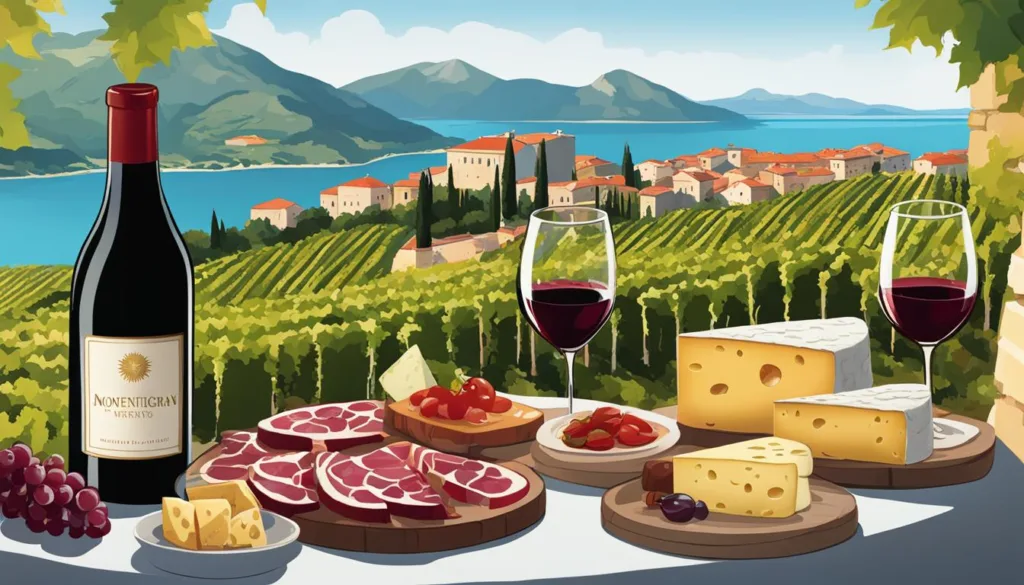
Rakija: Discovering Montenegro’s Signature Spirit
No narrative of Montenegro’s libations is complete without homage to Rakija. This emblematic spirit, revered as a hallmark of Montenegrin culture, distills not merely fruits but the very essence of festivity and kinship. An encounter with Rakija, savored in the congenial Montenegrin environs, suffuses the palate with a courage and warmth concurrent with the country’s inviting spirit.
A Tour of Montenegro’s Artisanal Cheese and Dairy
Immersing in the heart of Montenegro’s culinary tradition requires a taste of the country’s artisanal cheeses, epitomized by the renowned Pljevaljski Sir. Crafted from the milk of sheep grazing on the undulating pastures, this cheese is celebrated for its intense flavor and crystalline texture.
Montenegrin dairy is more than a food item; it’s a symbol of the nation’s connection to a time-honored way of life. Beyond Pljevaljski Sir, Montenegro is a treasure trove of traditional dairy products. Each region imparts a unique signature, from the richness of the mountain milk to the herbal notes carried in the cheese from the seaside pastures.
- Artisanal Montenegrin Cheese: A diverse range including the soft and spreadable Kajmak, to the aged and piquant Njeguski cheese.
- Montenegrin Dairy Delicacies: Fresh, creamy yogurts and tangy buttermilks that speak to the purity of the land’s bounty.
- Traditional Dairy Products: The simplicity of homemade sour cream and the rustic charm of unpasteurized milk, served in local konobas (taverns).
Embrace the savour of Montenegro’s pastoral narrative by indulging in the artisanal offerings and appreciate why these dairy delights are essential to the fabric of Montenegrin cuisine.
Sweet Indulgences: Montenegro’s Dessert Craftsmanship
The aromatic allure of freshly baked goodies signals the end to a feast of Montenegrin origin. Celebrated as much for their sumptuous flavors as for their delightful presentation, Montenegrin desserts are a testament to the finesse of dessert craftsmanship. Two such traditional Montenegrin sweets that have been warming hearts for generations are Krostule and Priganice, each with their own unique stories and textures.
The Art of Making Krostule and Priganice
With a legacy as crisp and sweet as the desserts themselves, the creation of Krostule and Priganice involves time-honored methods passed down through centuries. The exquisite dance of kneading, rolling, and frying transforms simple ingredients into crisp, golden Krostule, often generously dusted with powdered sugar. On the other hand, Priganice are delightful dough balls, their surface crackled to perfection, sometimes punctuated with the zest of citrus or a sprinkle of sweet sugar.
Tradition and Taste in Montenegrin Dessert Recipes
Any epicurean tour within Montenegrin borders will attest to the pride with which these desserts are crafted. Their traditional recipes, characterized by a harmonious blend of locally sourced ingredients, speak of a culinary heritage that cherishes its sweet conclusions as much as any other course. As focal points at celebrations and everyday tables alike, these traditional Montenegrin sweets offer a taste of Montenegro’s communal spirit and the charm of its confectionary art.
| Montenegrin Dessert | Key Ingredients | Texture | Occasion |
|---|---|---|---|
| Krostule | Flour, eggs, sugar, lemon zest | Light, crispy | Festive and family gatherings |
| Priganice | Flour, yeast, sugar, rakija or milk | Soft, chewy center with a crunchy exterior | Common breakfast treat or festival food |
In the culinary tapestry that Montenegro weaves, the sweet chapter is as vibrant as any other. From the crunch of Krostule to the softness of Priganice, these treats not only conclude a meal but also perpetuate the stories and warmth of Montenegrin culture. This dessert craftsmanship, an integral part of Montenegro’s gastronomic identity, invites locals and travelers alike to savor a piece of heritage that is both preserved and cherished to this day.
Highlighting Montenegro’s Famous Restaurants and Culinary Tours
Those longing for a delectable encounter with authentic Balkan delights are spoilt for choice with the best Montenegrin restaurants offering a blend of warm hospitality and exquisite dishes. At the heart of these eateries lies a commitment to local gastronomy, ensuring every meal is an immersive exploration of Montenegro’s rich food culture.
Where to Dine: Experiencing Local Gastronomy
In the quest for traditional flavors, one cannot overlook Konoba Catovica Mlini and Stari Mlini Restaurant, two culinary gems that have become synonymous with Montenegro’s epicurean scene. These restaurants not only serve food culture exploration through their menus but also boast atmospheric settings that are as memorable as the meals themselves.
Culinary Tours: Engaging with Montenegrin Food Culture
For a comprehensive insight into the nation’s edible heritage, Montenegro culinary tours are the perfect accompaniment. These tours transport the curious gourmand through Kotor’s winding streets and Podgorica’s vibrant markets, offering an irresistible mix of history, tasting sessions, and cooking demonstrations. Visitors will leave with not just satisfied palates, but enriched minds—attuned to the subtle narratives woven into each dish’s creation.
- Konoba Catovica Mlini: Immerse in the ambient charm while enjoying fresh-caught seafood.
- Stari Mlini Restaurant: Revel in traditional dishes set within a serene, historic mill.
- Kotor Culinary Walks: Discover the medieval town’s secrets and sample local cheese and wines.
- Podgorica Gourmet Tours: Dive deep into Montenegro’s capital culinary diversity, from bustling markets to esteemed restaurants.
Riveting and palatable, these dining and tour experiences in Montenegro are essential stops on any gastronome’s journey, helping to appreciate the intricate tapestry that is Montenegrin cuisine.
Conclusion
Embarking on a Montenegro culinary experience is akin to opening a treasure chest of flavors, each dish presenting its own story and heritage. The mosaic of traditional Montenegrin dishes is a testament to the diverse cultural infusions that have shaped the nation’s palate. From the sizzle of Cevapi to the tangy bliss of Kotor Bay oysters, there’s an authenticity here that is palpable in every bite.
Our exploration through the lanes of flavorful meats, the allure of cheese and the sweetness of Montenegrin desserts anchors us in a culinary narrative that is rich with history and regional pride. The assortment of authentic Montenegrin recipes shared within this guide ensures that enthusiasts and epicureans alike can continue to revel in and recreate the Montenegro dining experience, wherever they may be.
Whether a seasoned traveler or a curious foodie, this Montenegrin food guide aims to serve not just as a compass through the gastronomic landscape but also as an invitation to experience the genuine warmth and rustic charm of Montenegrin hospitality. Bon appétit, or as the locals would say, ‘Prijatno’!
FAQ
What are some traditional Montenegrin dishes I should try?
Be sure to sample Burek (savory pastry), Cevapi (grilled sausage meat), and Njeguski Steak for meat lovers. Vegetarians can enjoy Sopska and Shopska Salads, as well as Kačamak (a creamy cornmeal dish). For dessert, try Krostule (crispy dough pastry) and Priganice (Montenegrin doughnuts).
Can you tell me more about Montenegrin cuisine’s historical influences?
Montenegrin cuisine has been shaped by a variety of historical influences, including Ottoman and Austro-Hungarian empires, as well as regional Mediterranean and Balkan traditions. This melange has resulted in a unique culinary landscape that is both diverse and deeply rooted in tradition.
What are some Montenegrin seafood specialties?
The Montenegrin coast offers fresh seafood delights such as Riblja Čorba (fish stew), Pastrmka na žaru (grilled trout), and the famous Kotor Bay oysters. Each dish showcases the fresh taste of the Adriatic Sea.
Does Montenegro have a wine and spirits tradition?
Indeed, Montenegro has a rich wine-making heritage featuring indigenous grape varieties like Vranac for reds and Krstac for whites. The local spirit Rakija, a potent fruit brandy, is also a key part of Montenegro’s traditional alcoholic beverages.
Are there any options for vegetarians in Montenegrin cuisine?
Yes, Montenegrin cuisine offers various vegetarian options that highlight the simplicity and wholesomeness of rural cooking traditions. Dishes like Kačamak and vibrant salads like the Montenegrin Salad provide nutritious and delicious options for vegetarians.
What kind of desserts can you find in Montenegro?
Montenegro’s desserts often incorporate dough and sugar, with traditional treats like Krostule (a type of fried pastry) and Priganice (similar to doughnuts), which reflect the art of Montenegrin dessert craftsmanship. Pita od Dunja (quince pie) is another beloved sweet treat.
Where can I sample authentic Montenegrin cuisine?
Authentic Montenegrin dishes are best experienced in local establishments such as Konoba Catovica Mlini and Stari Mlini Restaurant. For a more hands-on approach, culinary tours in places like Kotor and Podgorica offer interactive experiences with cooking classes and historical insights.
What type of cheese and dairy products are unique to Montenegro?
Montenegro produces a range of artisanal cheeses, with Pljevaljski Sir, a sheep’s milk cheese, being one of the most notable. Dairy products often accompany traditional meals, giving you a taste of Montenegro’s pastoral heritage.
Can I join culinary tours in Montenegro?
Yes, there are culinary tours available that offer a deep dive into local gastronomy, providing opportunities to engage with Montenegrin food culture through tastings, cooking classes, and historical narratives.
